The Transformation of Business Intelligence Over the Years

Business Intelligence (BI) refers to the process of extracting valuable insights from data to enable informed decision-making. BI tools help businesses evaluate performance and optimize processes. Nearly 50% of all businesses already use BI tools. Implementing BI offers a myriad of benefits, from better analysis to an increase in competitive advantage. The history of BI can be traced back to the 1950s, evolving from IT-controlled data processing to self-service analytics and now to augmented analytics.
The Early Days of Business Intelligence
Origins and Initial Concepts
Early Data Collection Methods
In the early 1800s, organizations began using simple tabular reports and graphs for data analysis. These methods provided a basic framework for understanding business performance. The creation of the first electronic calculator in the early 1960s marked a significant milestone. This innovation improved efficiency in data processing. By the late 1950s, Hans Peter Luhn published an article on Business Intelligence systems. This publication laid the foundation for modern BI understanding.
Initial Analytical Tools
The 1960s saw the rise of computers and advanced data analysis techniques. Businesses started adopting more sophisticated tools to analyze data. The development of BI systems during this period allowed organizations to gain deeper insights into their operations. The introduction of these initial analytical tools marked the beginning of a new era in data-driven decision-making.
The Role of IT in Early BI
Mainframe Computers
Mainframe computers played a crucial role in the early days of Business Intelligence. These powerful machines enabled large-scale data processing and storage. Organizations relied on mainframes to handle vast amounts of data. The use of mainframe computers in BI allowed businesses to perform complex calculations and generate detailed reports.
Early Software Solutions
The 1980s witnessed the growth of BI vendors and the development of specialized BI tools. Early software solutions emerged to help businesses manage and analyze data more effectively. These tools provided value by uncovering insights that were previously hidden. The release of Windows 95 in 1995 transformed data production and consumption. This transformation made BI tools more accessible to a broader audience.
The Rise of Data Warehousing and OLAP

Introduction to Data Warehousing
Key Concepts and Benefits
Data warehousing emerged as a pivotal development in the field of Business Intelligence (BI). A data warehouse serves as a centralized repository for storing large volumes of data from various sources. This architecture allows businesses to consolidate information, ensuring data consistency and accuracy.
Key benefits of data warehousing include:
Enhanced Data Quality: Centralized storage improves data integrity.
Improved Decision-Making: Access to comprehensive data enables better analysis.
Historical Insight: Data warehouses store historical data, allowing trend analysis over time.
Major Players and Technologies
Several major players have shaped the data warehousing landscape. IBM, Oracle, and Microsoft have been instrumental in developing robust data warehousing solutions. These companies provide advanced technologies that support efficient data storage and retrieval.
Technologies such as ETL (Extract, Transform, Load) processes play a crucial role. ETL tools help in extracting data from various sources, transforming it into a suitable format, and loading it into the data warehouse. Popular ETL tools include Informatica, Talend, and Apache Nifi.
Online Analytical Processing (OLAP)
Evolution of OLAP
Online Analytical Processing (OLAP) revolutionized the way businesses analyze data. OLAP systems enable multi-dimensional analysis, allowing users to view data from different perspectives. The evolution of OLAP began with simple reporting tools and progressed to sophisticated analytical platforms.
Early OLAP systems relied on pre-computed data cubes. These cubes allowed quick data retrieval but required significant storage space. Modern OLAP solutions leverage in-memory processing, enhancing speed and efficiency.
Impact on Business Decision-Making
OLAP has had a profound impact on business decision-making. Companies can perform complex queries and generate detailed reports in real-time. This capability empowers organizations to make informed decisions quickly.
Case studies highlight the benefits of OLAP solutions. For instance, cloud-based OLAP systems have enabled companies to optimize spending on analytics infrastructure. Businesses have maximized ROI by leveraging scalable and cost-effective cloud solutions.
The Advent of Big Data and Advanced Analytics

Emergence of Big Data
Characteristics of Big Data
Big Data refers to extremely large datasets that traditional data processing tools cannot handle. These datasets exhibit three main characteristics:
Volume: The sheer amount of data generated every second.
Velocity: The speed at which new data is created and processed.
Variety: The different types of data, including structured, semi-structured, and unstructured.
These characteristics distinguish Big Data from traditional BI data. Businesses can now analyze diverse data types to gain deeper insights and drive innovation.
Technologies Enabling Big Data
Several technologies enable the processing and analysis of Big Data. Key technologies include:
Hadoop: An open-source framework that allows for distributed storage and processing of large datasets.
Spark: A fast and general-purpose cluster computing system that enhances data processing speed.
NoSQL Databases: Databases like MongoDB and Cassandra designed to handle unstructured data efficiently.
These technologies have revolutionized the field of Business Intelligence (BI) by allowing businesses to process vast amounts of data quickly and efficiently.
Advanced Analytics Techniques
Machine Learning and AI
Machine Learning (ML) and Artificial Intelligence (AI) represent advanced analytics techniques that have transformed BI. ML algorithms learn from data to make predictions or decisions without explicit programming. AI encompasses broader capabilities, including natural language processing and computer vision.
Businesses use ML and AI to automate processes, enhance customer experiences, and optimize operations. For example, retail companies use ML algorithms to predict customer preferences and personalize marketing campaigns.
Predictive and Prescriptive Analytics
Predictive analytics involves using historical data to forecast future events. This technique helps businesses anticipate trends and make proactive decisions. Common applications include sales forecasting, risk management, and customer churn prediction.
Prescriptive analytics goes a step further by recommending actions based on predictive insights. This technique uses optimization and simulation algorithms to suggest the best course of action. For instance, supply chain managers use prescriptive analytics to optimize inventory levels and reduce costs.
The Modern Era of Business Intelligence
Self-Service BI Tools
Key Features and Benefits
Self-service BI tools have revolutionized how businesses interact with data. These tools empower users to create reports and dashboards without relying on IT departments. Key features include:
User-Friendly Interfaces: Intuitive drag-and-drop functionalities make data analysis accessible to non-technical users.
Ad Hoc Reporting: Users can generate reports on the fly, addressing specific business questions as they arise.
Data Visualization: Advanced visualization options help in presenting data insights clearly and effectively.
Customizable Dashboards: Personalized dashboards allow users to monitor key performance indicators (KPIs) relevant to their roles.
The benefits of self-service BI tools are substantial. Businesses experience faster decision-making processes due to immediate access to data insights. Operational efficiency improves as users can independently analyze data. Enhanced collaboration occurs when team members share insights through interactive dashboards.
Popular Tools in the Market
Several popular self-service BI tools dominate the market. Power BI stands out for its advanced capabilities and user-friendly interface. This platform supports both novice users and advanced analysts, making it versatile. Zoho Analytics offers robust features like automatic data syncing and personalized reports. This tool excels in providing in-depth reporting and data analysis.
Other notable tools include:
Tableau: Known for its powerful data visualization capabilities.
Qlik Sense: Offers associative data indexing, enabling users to explore data freely.
Looker: Provides a modern approach to BI with integrated data modeling and analytics.
Real-Time Analytics
Importance in Today's Business Environment
Real-time analytics has become crucial in today's fast-paced business environment. Companies need to make decisions based on the most current data available. Real-time analytics allows businesses to monitor operations continuously and respond swiftly to changes.
Key advantages include:
Immediate Insights: Access to up-to-the-minute data enables quick decision-making.
Enhanced Customer Experience: Businesses can personalize interactions based on real-time customer behavior.
Operational Efficiency: Real-time monitoring helps in identifying and addressing issues promptly.
Industries such as finance, retail, and healthcare benefit significantly from real-time BI. Financial institutions use real-time data to detect fraudulent activities. Retailers optimize inventory management by tracking sales in real-time. Healthcare providers improve patient care through real-time monitoring of health metrics.
Technologies Enabling Real-Time Analytics
Several technologies enable real-time analytics in BI. Key technologies include:
In-Memory Computing: This technology stores data in RAM, allowing rapid data processing and retrieval.
Stream Processing: Tools like Apache Kafka and Apache Flink process data streams in real-time, ensuring timely insights.
Cloud-Based Solutions: Cloud platforms provide scalable infrastructure for real-time data processing and analytics.
These technologies have transformed BI, making real-time data analysis feasible and efficient. Businesses leverage these advancements to stay competitive and agile in a dynamic market.
Future Trends in Business Intelligence
AI and Machine Learning Integration
Potential Impacts and Innovations
Artificial Intelligence (AI) and Machine Learning (ML) will continue to revolutionize BI. AI can automate data analysis, generate insights, and predict outcomes. These capabilities redefine how organizations interact with data. Companies can examine data in real-time, identify patterns, and make better predictions.
AI advances BI through improved content generation and automation. Predictive analytics become more accurate and efficient. Businesses can leverage AI to enhance customer experiences and optimize operations. Retail companies use ML algorithms to personalize marketing campaigns. Financial institutions employ AI to detect fraudulent activities.
AI integration in BI platforms promotes sophisticated analyses. Predictive modeling and statistical analysis become more accessible. Data science methods are increasingly embedded within BI tools. This integration allows for more comprehensive and insightful data analysis.
Increased Focus on Data Governance and Security
Importance and Challenges
Data governance and security have become critical in the modern BI landscape. Organizations must ensure data integrity, privacy, and compliance. Effective data governance frameworks help maintain data quality and consistency. Businesses need robust security measures to protect sensitive information.
The importance of data governance cannot be overstated. Accurate data enables better decision-making and strategic planning. Consistent data practices reduce errors and improve operational efficiency. Regulatory compliance is essential to avoid legal repercussions and maintain trust.
However, challenges in data governance and security persist. Managing large volumes of data from various sources can be complex. Ensuring data accuracy and consistency requires continuous effort. Cybersecurity threats pose significant risks to data integrity and privacy. Organizations must invest in advanced security technologies and practices.
In conclusion, future trends in BI will focus on AI integration and enhanced data governance. These advancements will drive innovation and improve business performance. Companies that adopt these trends will gain a competitive edge in the market.
The evolution of BI has transformed the way businesses handle data. From early data collection methods to advanced analytics, each phase marked significant progress. BI tools now offer user-friendly interfaces and real-time insights, empowering decision-makers to act swiftly.
The ongoing importance of BI in business cannot be overstated. Companies rely on BI for informed decision-making, operational efficiency, and competitive advantage. The integration of AI and machine learning promises further advancements.
Future developments in BI will enhance data analysis, scalability, and predictive capabilities. Businesses that embrace these innovations will gain a competitive edge.
See Also
The Significance of Big Data Tools and Data Engineering
Key Steps and Best Practices for Data Pipeline Construction
